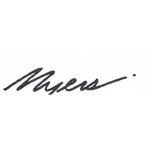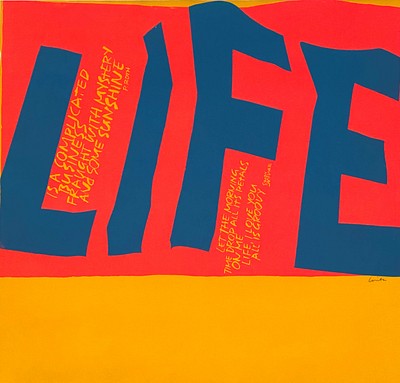Bert Stern (1929-2013) Signed Marilyn Monroe Foto
Two ways to bid:
- Leave a max absentee bid and the platform will bid on your behalf up to your maximum bid during the live auction.
- Bid live during the auction and your bids will be submitted real-time to the auctioneer.
Bid Increments
| Price | Bid Increment |
|---|---|
| $0 | $10 |
| $100 | $25 |
| $500 | $50 |
| $1,000 | $100 |
| $2,500 | $250 |
| $5,000 | $500 |
| $10,000 | $1,000 |
| $15,000 | $2,500 |
| $50,000 | $5,000 |
| $100,000 | $10,000 |
About Auction
Apr 30, 2023
Fine Art Auction - 35th Anniversary Myers Antiques auctions@myersfineart.com
- Lot Description
Bert Stern (American, 1929-2013) Marilyn Monroe Signed Bert Stern Fotografie Magazine. Fotografie portfolio no.49, your personal copy stamped Nr.00088 on first page. Autographed For Nancy with fondest past memories, Bert Stern 10/06/07. This magazine was presented to Stern’s former assistant Nancy Ann Reals Perl Benderoth (1933-2019) and from her East Hampton NY estate. In good condition.
From Wikipedia: Stern was the son of Jewish immigrants and grew up in Brooklyn. His father worked as a children's portrait photographer. After dropping out of high school at the age of 16, he gained a job in the mail room at Look magazine. He became art director at Flair magazine, where Stern learned how to develop film and make contact sheets, and started taking his own pictures. In 1951, Stern was drafted into the United States Army, sent to Japan and assigned to the photographic department. In the 1960s, his heavy use of amphetamines led to the end of his marriage to ballerina Allegra Kent. He was one of the last photographers to shoot Marilyn Monroe, in June and July 1962 for Vogue magazine. Monroe died in August 1962. These sessions became known as The Last Sitting; The 2571 photographs taken on these sessions were published after her death in The Complete Last Sitting in 1992. In the 1970s, Stern moved to Spain to recover from his drug addiction. By the late 1970s, Stern returned to the U.S. to photograph portraits and fashion. In 1979, he published The Pill Book, along with journalist Lawrence Chilnick. This A to Z guide of the most prescribed drugs in the US, which sold 18 million copies, included color photographs of the pills by Stern.
Biography from Janet Lehr Fine Arts Photographer Bert Stern spent three sessions with Marilyn Monroe shooting for Vogue Magazine in Los Angeles Hotel Bel-Air in late June 1962, six weeks before the great star's death. These sessions produced extraordinarily beautiful and unique images of Marilyn. Bert Stern's career exemplifies the concept of the commercial photographer as a cultural hero. Money, power, and celebrity have made him almost as much of an icon as the famous faces he has photographed. He has become the prototype of the fashion photographer as the embodiment of glamour. Stern's photography career happened almost as a fluke. Working as a messenger and mail clerk at Look magazine in 1947, Art Director Herschel Bramson, recognizing something special, encouraged Stern to study art books at the library, and visit the Museum of Modern Art. But it was Irving Penn's work that really galvanized Stern's desire to be a photographer. Drafted during the Korean War, Stern photographed the troops' ships heading to Japan. These later became his first published photographs. Upon his return to the United States, Stern explored advertising photography, and achieved success with his work for Smirnoff Vodka, including one of the most famous images: A Giza pyramid reflected upside down in a martini glass. Bert Stern went on to photograph for Vogue, the premiere fashion magazine, and married Allegra Kent, a principal dancer with the New York Ballet. These events expanded his interest in shooting the arts, and he began to concentrate his efforts on fashion and celebrity portraiture. His best known work is arguably a collection of 2,500 photographs, some nude or semi-nude, taken of Marilyn Monroe, American idol's, in three sittings over a three day period, six weeks before her death. As they were the last posed photographs taken of Monroe, the portfolio has come to be known as The Last Sitting. The photographs were taken for Vogue, who published several of them following Monroe's death. Vogue wanted the Marilyn Monroe shoot and Marilyn Monroe chose Bert Stern as her photographer. A book containing these photographs, including copies of proofs over which Monroe had written comments, or crossed out with lipstick, was published in 1992 with the title Marilyn Monroe: The Complete Last Sitting.
From the EastHamptonStar - Feb. 21, 2018:Obituary - Nancy Ann Reals Perl Benderoth, an artist, designer, and producer of a documentary film that was nominated for an Academy Award, died at her Jericho Road, East Hampton, house on Feb. 6. Her family, who were with her at the end, said the cause of death was cardiac arrest brought on by pneumonia. She was 84 and had been in declining health for several years. She was born to Barney Reals and the former Annabel Whitney in Brooklyn on April 26, 1933, and grew up in the gated community of Seagate, adjacent to Coney Island. A lifelong painter, she attended Cooper Union and the Art Students League, both in Manhattan. Locally, she studied at the Art Barge on Napeague with Victor D’Amico of the Museum of Modern Art. Ms. Perl also worked as an assistant to other artists and as a stylist for such well-known photographers as Bert Stern and Irving Penn. At one time, she had a career in advertising, working for Mary Wells Lawrence at Wells, Rich, and Greene. Her husband had been collaborating with James Baldwin on a dramatic production of the life of Malcolm X, which eventually became a film. It was was incomplete when Mr. Perl died, and Ms. Perl, a producer on the project, stepped in. Working with the editor of the film, Mick Benderoth, the film was completed, and was nominated for an Academy Award in 1972. Ms. Perl and Mr. Benderoth began collaborating both professionally and personally. They formed a film production company, called Benderoth-Perl, and were married on Christmas Eve in 1990. She and Arnold Perl, a playwright, screenwriter, and producer were married in 1956. A former member of the Communist Party, Mr. Perl had been blacklisted and sold television scripts through a front. Though not a member of the Communist Party, she shared many of her husband's political beliefs. They met in the world of theater through Bernard Gersten, co-founder along with Joseph Papp of the Public Theater in Manhattan. She was an informal consultant on costumes and props for the 1953 stage production of Sholem Aleichem, which her husband wrote. Mr. Perl also wrote Tevya and His Daughters, a basis for Fiddler on the Roof. In the early 1960s, the Perl family began summering in East Hampton. They were attracted by the many artists and writers and found many kindred spirits here. The family rented a house on Jericho Road for the summer of 1964, with the understanding that the rent could be applied toward a purchase price. They bought it for $36,000. A few years later, the couple also purchased a townhouse on East 18th Street in Manhattan. East Hampton became the center of their family's life, however, said Sarah Perl, one of the couple's daughters, and enjoyed living year round here. They were not religious and celebrated both Jewish culture and heritage as well as Christmas. Ms. Perl said yesterday that when the family spent a Christmas away from Jericho Road, in a house without a fireplace, she asked her mother how Santa would get in. Don't worry, was the answer, I will let him in. Ms. Perl Benderoth loved spending long days at Georgica Beach or Louse Point, going in the morning and staying until sunset. Her daughter said her mother would frequently take a black skillet and a stick of butter to Louse Point, where they would seine for and fry minnows. She would often stuff plums into the bottom of an ice-packed carrier. You would stick your arm in up to your elbow, and pull them out, Ms. Perl recalled. Her mother opened the Boutique at Enrico Caruso at 110 East 55th Street in Manhattan in 1965, where, her daughter said she sold the best of everything, including Viennese pastries made by her 70-year-old mother in a tiny kitchen in the Stuyvesant Town apartment complex. - Shipping Info
-
All shipping arrangements and costs are the sole responsibility of the buyer. We are happy to assist in the transfer of merchandise to a shipper of your choice. Buyers should request a shipping quote prior to bidding. There are reliable shipping companies to use, and they include:
(1) The UPS Store:
Charlie Mosher
301 West Platt St
Tampa, FL 33606
(813) 251-9593
store3751@theupsstore.com
www.theupsstore.com/3751For a shipping quote, click the link below to get started on a quote OR to make payment for an existing quote: MyAuctionQuote.com/myers
(2) The UPS Store:
RayAnna Brodzinski
740 4th Street North
St. Petersburg, FL 33701
(727) 513-2400
shipping@store6886.com
www.theupsstore.com/6886(3) The UPS Store:
Rian Fehrman
5447 Haines Rd N,
St. Petersburg, FL 33714
(727) 528-7777
store6173@theuspsstore.com
www.theupsstorelocal.com/6173(4) Family Pak & Ship
Amel & Mohamed Hamda
2822 54th Avenue S.
St. Petersburg, FL 33712
727 865-2320
Raman@familypakandship.com
www.familypakandship.com(5) The UPS Store:
Gina Farnsworth
204 37th Ave N.
St Petersburg, FL 33704
(727) 822-5823
store3146@theupsstore.com
www.theupsstore.com/3146(6) The UPS Store:
200 2nd Ave South
St Petersburg, FL 33701
(727) 826-6075
store3248@theupsstore.com
www.theupsstore.com/3248(7) Craters & Freighters
(813) 889-9008
Fax (813) 884-8393
Tampa@cratersandfrighters.com
www.cratersandfreighterstampa.com (U.S. & International)(8) Orbit Professional Packing Crating
(888) 247-8540 or (727) 507-7447
lg@orbitppc.com
www.orbitppc.com (U.S. & International)LARGER ITEMS SHIPPING SUGGESTIONS
For items too large for standard shipping, such as furniture:
(1) Plycon - Furniture Transportation Specialists"
(954) 978-2000 (U.S. only)
lisa@plycongroup.com
www.plyconvanlines.com
You must submit a request on-line.(2) All Directions Moving
Specialist in moving furniture from FL to NY.
941-758-3800
alldirections@comcast.net
(3) Craters & Freighters
(813) 889-9008 or (877) 448-7447
Tampa@cratersandfreighters.com
(U.S. & International).(4) Westbrook Moving LLC
Makes regular trips up and down the east coast.
(404) 877-2870
westbrookdeliveries@gmail.com(5) Eastern Express
Owner Jeff Bills makes regular trips up and down the east coast.
(843) 557-6633
jb101263@yahoo.com(6) Can Ship US
Owner makes trips from Florida to Canada
Steve Fleury (905) 301-4866
canshipus@gmail.comThere are many other local and national shippers available in our area that we can refer you to. We are not responsible for any delays on the part of this third party shipper, should there be any. We recommend shipping all items insured. Should any damage occur to items transported by a third party, we are not held responsible. In the event that an item is approved for a return, shipping is not refundable.
-
- Buyer's Premium



 EUR
EUR CAD
CAD AUD
AUD GBP
GBP MXN
MXN HKD
HKD CNY
CNY MYR
MYR SEK
SEK SGD
SGD CHF
CHF THB
THB















